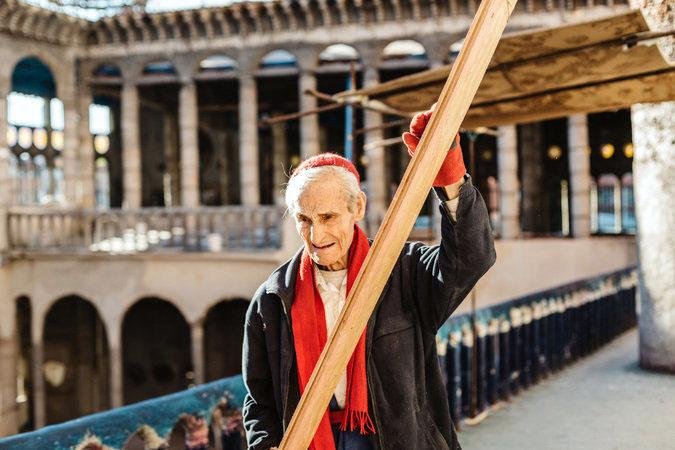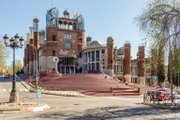MEJORADA DEL CAMPO, Spain -- In February, Justo Gallego dug his own grave, literally, in the crypt of the church he has been building here, brick by brick, since the early 1960s.
Gallego, 91, also recently switched dwellings, moving from the nearby home of some relatives to the more spartan surroundings of his self-made temple. He wants to make certain that he will die in the place that has become his life's mission.
"This is where my vocation has taken me and this is where I'm prepared to suffer, just as Jesus Christ taught us to suffer for others," said Gallego, as he threw wood onto a stove by his rudimentary bedroom, next to the altar, where he sleeps on a plank without a mattress.
Gallego might be ready to confront death, but some residents here worry about what will happen to his extraordinary project without him. Gallego has never received a building permit or any public financing, but he has managed to erect a striking landmark in this otherwise nondescript town of 23,000 inhabitants on the outskirts of Madrid.
His ambitious undertaking is labeled the "Cathedral of Faith" on internet maps, even though it has received no official backing from officials of the Catholic church. Flanked by two cloisters and crowned by an unfinished 125-foot-tall cupola, it attracts tourists on the weekend, helping lift the local economy.
"This man has built something incredible against all odds and turned it into a symbol of our town," said Victor Morillo, a resident who can see the cupola from the balcony of his apartment. "The town hall should have done a lot more to help and should certainly not allow anything bad to happen to this cathedral after he dies."
Gallego, however, is unmoved by this kind of support, just as he has been unshaken by past criticism of his project and his own personality, sometimes compared to that of an exalted former monk. He is also unfazed that he has never received any public financing, even in a country that is mostly Catholic and whose infrastructure has been heavily subsidized.
"I've not been building this to get money or fame, just as I'm not here to listen to people decide whether I'm mad or unique," he said. "I'm fully responsible for my work and I'm not looking for the authorities to have any say."
Despite the lack of permits, no one is talking of tearing the church down, but neither is anyone certain of the project's long-term future.
Encarnacion Martin Alvarez, an official in charge of urban planning here, said the city could not finance Gallego because of budgetary constraints and had made no plan to guarantee the continuation of the project, whatever its growing importance to the town and its identity.
Gallego was born here in 1925, on the day of the town's patron saint, the Virgin of Sorrows. At 27, he joined a monastery in the northern province of Soria, but was ordered to leave eight years later, after he caught tuberculosis and risked contaminating the other monks.
After recovering in a Madrid hospital, Gallego returned to his hometown, where he decided to turn a family plot of land into a place of worship, without the blessing of the Catholic church.
He said his project was an act of faith, motivated in part by his desire to make amends for the desecration he witnessed during the Spanish Civil War. During the war, "I saw the communists destroy all the churches here, with people laughing and dancing in the ruins," he said. "But when you believe, you can then also rebuild with your own hands a beautiful new place."
Indeed, Gallego has put up most of the church himself, without any training as an architect or civil engineer, using recycled material ranging from food tins to misshapen bricks and other leftovers from local factories and construction sites.
The topmost section of some of the church's concrete pillars, called capitals, are made from secondhand car tires, painted gray to resemble the color of the concrete used for the pillar. Part of the roofing is still missing, but there are already frescoes on the walls.
Gallego has financed his work by selling family farmland, as well as through donations.
He has held religious ceremonies on the premises, but the ground has not been consecrated.
"Many members of the institutional church view him as a fanatic who shouldn't be taken seriously, but I consider him an example for humanity," said Maria Teresa Alonso, a retiree from a nearby town who visits occasionally and has donated money to help Gallego. "They say faith can move mountains, but here we see that faith can also build an incredible cathedral."
Gallego has received some informal support from members of the local clergy. "There have been complaints about him, but we support him in as far as we can," said Pedro Luis Jimenez Langa, a parish priest in town. "It's an exceptional work, and he's a good man."
With his health growing more fragile, Gallego has increasingly relied on friends and volunteers to help with construction. A local entrepreneur offered a crane to lift the cupola, while some admirers have donated religious sculptures and decorations rather than money.
But nothing gets added without Gallego's approval, particularly if it jars with the arches and other circular designs that he loves, which are loosely based on the Romanesque style.
"That's really not going to look good anywhere around here," Gallego said, as he studied a blue dove, made from raffia palm fibers, which was given as a donation, but which Gallego left lying on the floor.
While some have wondered about Gallego's mental health, his supporters dispute that there's anything unhealthy about his obsession.
"Do you really think somebody mad could have built something like this?" said Pablo Cantuel Gallego, a nephew, 64, who has been helping his uncle since he was a child. "The only problem with my uncle is that he belongs to a different century. He thinks and works like nobody could now imagine doing."
It is notable that Gallego's building is on a street named after Antoni Gaudi, the architect of Barcelona's world-famous and unfinished basilica, the Sagrada Familia.
Gaudi died in 1926, but other architects have taken over and hope to finish his basilica in time for the centennial of his death. Gallego, on the other hand, has no timetable and not even a single sketch of his cathedral project. But he does have one trusted assistant, Angel Lopez, who said he would take over the works when Gallego died.
"The only plan is made in my head, drawn day by day," Gallego said with a grin. "But Jesus Christ is the one who makes the real plans and decides what eventually should happen."
Religion on 04/22/2017

